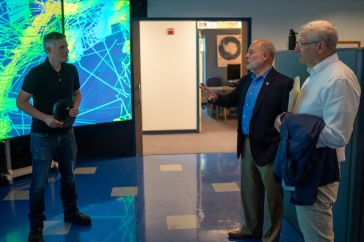
Photo courtesy of NASA.
In what’s being hailed as the largest single research contract ever awarded to UNH by NASA, researchers will receive $107.9 million to develop a space-based instrument to study coastal ecosystems near the Gulf of Mexico.
The interdisciplinary project team includes numerous UNH space scientists and is led by research associate professor of Earth sciences Joseph Salisbury. Together, they will develop the Geosynchronous Littoral Imaging and Monitoring Radiometer (GLIMR) instrument to observe ocean biology, chemistry and ecology throughout the Gulf of Mexico, the southeastern U.S. coastline and Amazon River plume that stretches to the Atlantic Ocean.
“GLIMR will help us address a tremendous number of research questions that we’ve never had information on from space, so it’s exciting to be part of that.”
"I am absolutely enthused by this selection by NASA to fund GLIMR,” says Harlan Spence, director for the UNH Institute for the Study of Earth, Oceans, and Space. “GLIMR provides novel measurements that are key to addressing important coastal science and have clear impacts for society. It also underscores the value of our interdisciplinary institute; our staff came together in a new way to produce UNH’s largest-ever single award,” he adds.
Oceans and coastlines are facing increasing pressure from the impacts of land use decisions and climate change. However, it can be difficult to frequently monitor these impacts via satellites due to their position in orbit; at best, they might pass over the Gulf of Mexico once per day, Salisbury says. GLIMR will pass by 8-10 times per day, taking highly detailed measurements of the ocean’s color. This will help scientists to identify various phytoplankton species — the base of the marine food chain — and how they respond to their environment. Scientists will also be able to track the plankton that contribute to harmful algal blooms and to monitor and project the movement of those blooms, along with the spread of sediments, oil spills or other pollutants.
“GLIMR will help us address a tremendous number of research questions that we’ve never had information on from space, so it’s exciting to be part of that,” Salisbury says.
GLIMR is slated for launch in 2026-2027, but the team has been laying the groundwork for this project for years. Salisbury’s research with the UNH Ocean Process Analysis Lab focuses on ocean acidification and the biogeochemistry of coastal waters near rivers. He says the inspiration to participate in GLIMR came from his mentor, Janet Campbell, UNH professor emeritus of Earth science who spent much of her career studying bio-optical oceanography.
Researchers including Doug Vandemark from the Ocean Processes Research Lab and others from the Space Science Center will work with the science data, while space scientists John Macri, Dave Rau, David Hiertzler and others will help to operate the spacecraft and ensure the data are delivered properly. “Realizing that we had a world-class space science center crew right here in the building marked a turning point in the success of this project proposal,” Salisbury says. “Their involvement has made all the difference in the world.”
The Institute for the Study of Earth, Oceans, and Space (EOS) is UNH’s largest research enterprise, comprising six centers with a focus on interdisciplinary, high-impact research on Earth and climate systems, space science, the marine environment, seafloor mapping, and environmental acoustics. With more than $43 million in external funding secured annually, EOS fosters an intellectual and scientific environment that advances visionary scholarship and leadership in world-class research and graduate education.
-
Written By:
Rebecca Irelan | Institute for the Study of Earth, Oceans, and Space | rebecca.irelan@unh.edu | 603-862-0990



















































